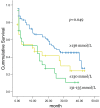The association between the serum sodium level and the severity of complications in liver cirrhosis
- PMID: 19543488
- PMCID: PMC2698618
- DOI: 10.3904/kjim.2009.24.2.106
The association between the serum sodium level and the severity of complications in liver cirrhosis
Abstract
Background/aims: Dilutional hyponatremia associated with liver cirrhosis is caused by impaired free water clearance. Several studies have shown that serum sodium levels correlate with survival in cirrhotic patients. Little is known, however, regarding the relationship between the degree of dilutional hyponatremia and development of cirrhotic complications. The aim of this study was to evaluate the association between the serum sodium level and the severity of complications in liver cirrhosis.
Methods: Data of inpatients with cirrhotic complications were collected retrospectively. The serum sodium levels and severity of complications of 188 inpatients were analyzed.
Results: The prevalence of dilutional hyponatremia, classified as serum sodium concentrations of <or=135 mmol/L, <or=130 mmol/L, and <or=125 mmol/L, were 20.8%, 14.9%, and 12.2%, respectively. The serum sodium level was strongly associated with the severity of liver function impairment as assessed by Child-Pugh and MELD scores (p<0.0001). Even a mild hyponatremia with a serum sodium concentration of 131-135 mmol/L was associated with severe complications. Sodium levels less than 130 mmol/L indicated the existence of massive ascites (OR, 2.685; CI, 1.316-5.477; p=0.007), grade III or higher hepatic encephalopathy (OR, 5.891; CI, 1.490-23.300; p=0.011), spontaneous bacterial peritonitis (OR, 2.562; CI, 1.162-5.653; p=0.020), and hepatic hydrothorax (OR, 5.723; CI, 1.889-17.336; p=0.002).
Conclusions: Hyponatremia, especially serum levels <or=130 mmol/L, may indicate the existence of severe complications associated with liver cirrhosis.
Keywords: Hyponatremia; Liver cirrhosis.
Figures
Similar articles
-
Hyponatremia in cirrhosis: Risk factors and prognostic value.Tunis Med. 2016 May;94(5):401-405. Tunis Med. 2016. PMID: 27801493
-
Validation of model for end-stage liver disease score to serum sodium ratio index as a prognostic predictor in patients with cirrhosis.J Gastroenterol Hepatol. 2009 Sep;24(9):1547-53. doi: 10.1111/j.1440-1746.2009.05913.x. Epub 2009 Aug 3. J Gastroenterol Hepatol. 2009. PMID: 19686416
-
Hyponatremia in cirrhosis: Results of a patient population survey.Hepatology. 2006 Dec;44(6):1535-42. doi: 10.1002/hep.21412. Hepatology. 2006. PMID: 17133458
-
Hyponatremia in cirrhosis: clinical features and management.Gastroenterol Clin Biol. 2006 Oct;30(10):1144-51. doi: 10.1016/s0399-8320(06)73492-3. Gastroenterol Clin Biol. 2006. PMID: 17075468 Review.
-
Complications of cirrhosis. II. Renal and circulatory dysfunction. Lights and shadows in an important clinical problem.J Hepatol. 2000;32(1 Suppl):157-70. doi: 10.1016/s0168-8278(00)80423-7. J Hepatol. 2000. PMID: 10728802 Review.
Cited by
-
Hyponatremia in Chronic Liver Disease among Patients Presenting to a Tertiary Care Hospital: A Descriptive Cross-sectional Study.JNMA J Nepal Med Assoc. 2021 Dec 11;59(244):1225-1228. doi: 10.31729/jnma.7152. JNMA J Nepal Med Assoc. 2021. PMID: 35199775 Free PMC article.
-
Effects of bile duct ligation on the inhibitory control of supraoptic vasopressin neurons.J Neuroendocrinol. 2023 Jun;35(6):e13312. doi: 10.1111/jne.13312. Epub 2023 Jun 19. J Neuroendocrinol. 2023. PMID: 37337093 Free PMC article.
-
KASL clinical practice guidelines for liver cirrhosis: Ascites and related complications.Clin Mol Hepatol. 2018 Sep;24(3):230-277. doi: 10.3350/cmh.2018.1005. Epub 2018 Jul 9. Clin Mol Hepatol. 2018. PMID: 29991196 Free PMC article. Review. No abstract available.
-
Study of electrolyte disturbance in chronic liver disease patients attending a hospital in Kumaon region.J Family Med Prim Care. 2022 Aug;11(8):4479-4482. doi: 10.4103/jfmpc.jfmpc_404_22. Epub 2022 Aug 30. J Family Med Prim Care. 2022. PMID: 36353013 Free PMC article.
-
[Impact of training about cervical cancer screening on health professionals working in basic health care units].Rev Bras Ginecol Obstet. 2014 Apr;36(4):182-7. doi: 10.1590/s0100-7203201400040004. Rev Bras Ginecol Obstet. 2014. PMID: 24860977 Free PMC article.
References
-
- Angeli P, Wong F, Watson H, Gines P. Hyponatremia in cirrhosis: results of a patient population survey. Hepatology. 2006;44:1535–1542. - PubMed
-
- Heuman DM, Abou-Assi SG, Habib A, et al. Persistent ascites and low serum sodium identify patients with cirrhosis and low MELD scores who are at high risk for early death. Hepatology. 2004;40:802–810. - PubMed
-
- Fernandez-Esparrach G, Sanchez-Fueyo A, Gines P, et al. A prognostic model for predicting survival in cirrhosis with ascites. J Hepatol. 2001;34:46–52. - PubMed
-
- Ripoll C, Banares R, Rincon D, et al. Influence of hepatic venous pressure gradient on the prediction of survival of patients with cirrhosis in the MELD Era. Hepatology. 2005;42:793–801. - PubMed
-
- Arroyo V, Rodes J, Gutierrez-Lizarraga MA, Revert L. Prognostic value of spontaneous hyponatremia in cirrhosis with ascites. Am J Dig Dis. 1976;21:249–256. - PubMed
Publication types
MeSH terms
Substances
LinkOut - more resources
Full Text Sources
Medical

